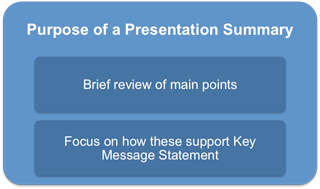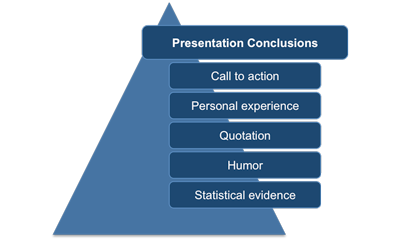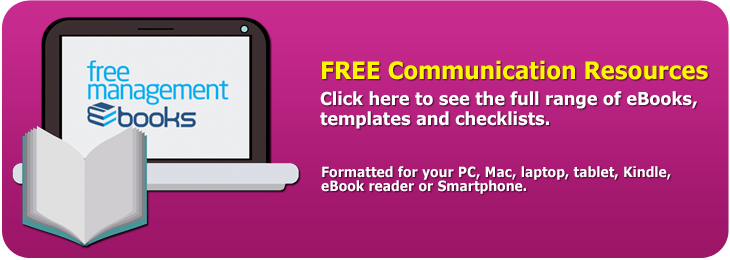Communication Skills - Preparing the Summary and Conclusion
Now you have defined the content of your main body (which in the case of our example consists of three key points), you move onto your summary. The way a presentation ends can have a big impact on the audience and defining its content needs to be carefully thought out.
 |
Some speakers find it difficult to draw things to a close. This is something that needs to be done explicitly and cleanly, so don't use phrases like 'in conclusion,' 'finally,' or 'just before I finish' unless you are about to stop speaking. Bringing things to a decisive close means treating the end of your presentation as two distinct tasks:
- The first is a brief summary of the main points. This can be derived directly from the introduction and differs only in that you will focus on reiterating your key points.
- The second is to focus the audience on what you want them to take away from the presentation by restating the key message statement and how the key points support it.
The function of the summary is to make it clear that you are moving towards the conclusion of the presentation. Once the audience knows that the ending is near they tend to sit up and concentrate even if their attention has been wandering up to that point.
You should make every attempt to make this conclusion as punchy and memorable as possible. Ideally your conclusion should be one single sentence that refers back to the key message statement. This link back to the opening theme or idea makes it appear that the presentation has a rounded structure and makes it look well planned and logical.
 |
There are several rhetorical techniques that you can use to make sure the wording of your conclusion is memorable:
- A call to action, if your aim is to persuade your audience to do or accept something.
- A personal experience that shows how one can benefit.
- Illustration by using a quotation.
- Using humor to demonstrate something.
- Using statistics to show the importance of your key message statement.
Your conclusion is the last impression you will leave with your audience so make it strong and distinctive. Make sure that your own enthusiasm and passion for your topic come across in your conclusion.
As you finish, you should make sure that you have a visual aid that summarizes the main message. You can even leave this visible during the question and answer period. By continuing to show this conclusion slide during the questions, you increase the chances that the audience will retain the key message.
When your time slot has come to an end or when all questions have been answered your final action is to thank you audience for coming and sparing you their time. It shows that you appreciate them scheduling your presentation into their busy day.
You may also be interested in:
Preparing a Management Presentation | Repetition and Timing | Your Presentation Aim | The Five-Stage Format | Preparing the Main Body | Key Point Guidelines | Finalizing the Main Body | Preparing Your Pre-Introduction | Preparing the Introduction.



